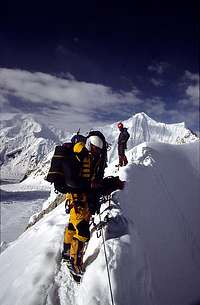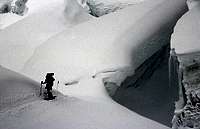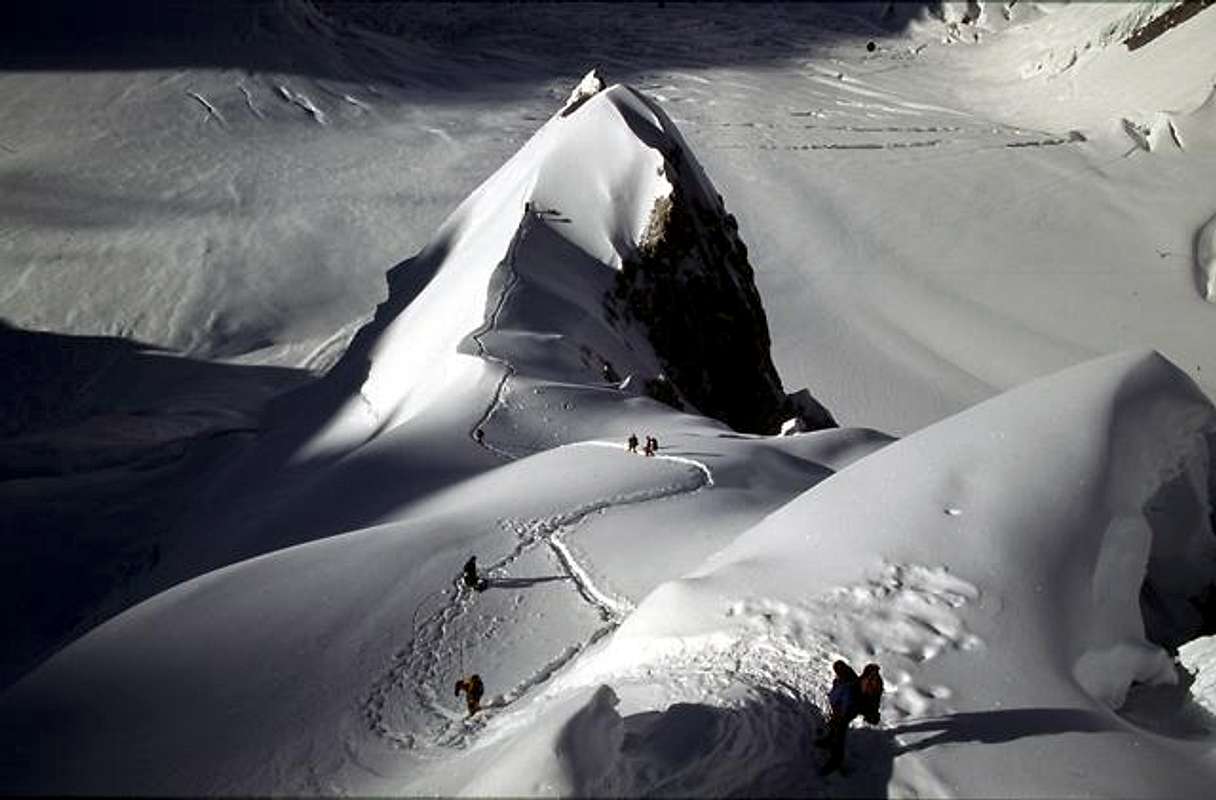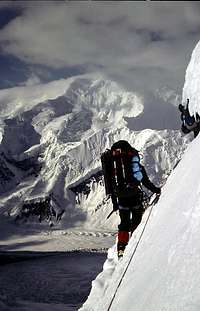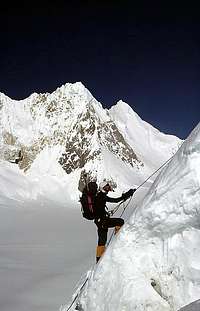|
|
Mountain/Rock |
|---|---|
|
|
35.76670°N / 76.65000°E |
|
|
Mountaineering |
|
|
26089 ft / 7952 m |
|
|
Overview
General overview
Gasherbrum III (G III) is located far away into the wilderness and that's one of the reasons it only has been summited twice. Even if the peak is one of the highest in the world at 7952 meters, usually ranked as number 15, very few climbers have it as a goal. The mountain can for sure blame this fact on its neighbours. G III is only the third highest in the Gasherbrum Group, where Gasherbrum I or Hidden Peak is the highest at 8068m. Second is Gasherbrum II at 8032m. The slightly lower, Gasherbrum IV is also a more interesting object to attempt as it's arguably the only peak considered a tougher climb than K2. Gasherbrum III was for a long time the highest unclimbed peak in the world.
The route is in the beginning the same as on the slightly higher Gasherbrum II, but high up on the G II's long SW ridge, you have to “take a left” under the impressive granite face of G II. This is also the route Carlos Carsolio took when he solo-climbed the face in 1995.
They say size doesn't matter, but in this case it does and if Gasherbrum I is Hidden Peak, Gasherbrum III may be called Forgotten Peak.
The Polish first ascent
In 1975 Wanda Rutkiewicz wanted to organize the first female expedition to the Himalayas/Karakorams. She and eight of her female partners had the permission to climb the then unclimbed Gasherbrum III. At the same time there was also a “male expedition” which wanted to climb new route on the right/east flank of Gasherbrum II. This party never received a permit, so they couldn’t go.
Even before departure some problems hit the expedition. In 1975 Poland was a communist country so everything (clothes, equipment, food, etc.) was difficult, sometimes almost impossible to get. Therefore every expedition wanted to get status of a national expedition, representing Poland. If receiving this status the PZA - Polski Zwiazek Alpinizmu (Polish Association of Alpinism) sponsor with money and helps out with organizing the expedition. Rutkiewicz’s team was depending on PZA’s support, but the organization didn't accept an all female expedition. The PZA came up with the idea of merging Rutkiewicz’s team with the team which were supposed to go to Gasherbrum II.
Officially the men should act like a support team and if the women failed to reach the summit, the male team would go for the second try on Gasherbrum III. The male team was also hoping to get the permission to climb Gasherbrum II upon arrival in Pakistan. They flew to Pakistan as one team, so when they arrived in base camp the liaison officer, Captain Saed gave male team the permission to climb Gasherbrum II. Bad luck struck the male team as the planned route on Gasherbrum II had been climbed only a few days before their arrival. The 18’th of June 1975 Frenchclimbers Yanick Seigneur and Mark Batard “stole” the route from the Poles.
They decided to climb with female team to the pass between Gasherbrum II and III and then turn right and climb the Gasherbrum II anyway. Leszek Cichy, Krzysztof Zdzitowiecki and Janusz Onyszkiewicz reached the top on 1’st of August. The same day the first attempt on Gasherbrum III was made by Halina Kruger-Syrokomska and Wanda Rutkiewicz. They didn’t manage to the ridge and had to turn back.
A few days later Captain Saed gave the whole Polish team permission to attempt also the normal route on Gasherbrum II. Some days later Marek Janas, Andrzej Lapinski and Leszek Wozniak climbed Gasherbrum II following the route of first summiteers. At the same time Alison Chadwick-Onyszkiewicz, Wanda Rutkiewicz, Janusz Onyszkiewicz and Krzysztof Zdzitowiecki reached the pass between Gasherbrum II and
III. They decided the ridge was too difficult so they tried to climb
a snowy couloir in the middle of east face. The plan was that women should try first and if they didn’t make it, the men would make a go for it.
On the 11’th of August the whole team of four climbers reached the summit of Gasherbrum III. The Women were a little bit disappointed that they hadn't managed to climb the mountain alone so Halina Kruger-Syrokomska, Anna Okopinska and Krystyna Palmowska started to climb the normal route on Gasherbrum II. Saed was climbing with them because he wanted to be the first climber from Pakistan to summit an
8000 meter peak. Unfortunately he fatigued during the summit attempt and Krystyna Palmowska helped him to walk down. Kruger-Syrokomska and Okopinska reached the top and became a first female team which climbed 8000 meters peak without male company. It was very important expedition because if they hadn't succeeded there would’ve been much more difficult to organize all-female expeditions in the future. The Russian all-female expedition on Pik Lenin in 1974, where all the expedition members died stopped Russian women expeditions for many years and other organizers where hesitant trying it out. The Polish Gasherbrum II expedition was therefore very important for female climbers all over the world.
The above section was written with help from jck.
Later ascents & attempts
It was not until 29 years later the summit was reached again, this time by two Basques, Alberto Iñurrategi and Jon Beloki made it to the top in 2004.
Second ascent: K2news-report, Ternua.com - brief and an article in Spanish on Desnivel.com.
In 2002 a new route on the southern rocky sections was attempted, but failed at an early stage.
Damien adds:
Geoff Cohen led a UK expedition to G3 in 1985 that attempted the long, rocky SW spur, from up near the icefall between G3 & G4. They got very high on the route but retreated as they felt too extended. I have the Himalayan Alpine Journal at home with the article and photos in it.
A UK army exped also attempted G3 in the 90s, via the G2 route, but got to the traverse (left turn at the pyramid) and retreated due to avalanche danger on the section across to G3 itself. There were a couple of photos in High mag at the time.
Long shadows in the early morning light. Some teams ascending, some are going down towards Camp 1, which is located just right of "The Tooth". This is one of the easier parts of the climb in between C 1 and C2. Only shorter sections with snow up to 70 degrees.
Getting There
Gasherbrum III is a long way from any arrival point in Pakistan. Sooner or later you have to pass Islamabad as this is the town where you get the permits for the peak. If an organizer have taken care of the arrangements for you, you can just relax and follow your guide through the country. If you want to arrange everything yourself, the following may be of help.
From Islamabad to The Northern Areas.
Local buses serve Islamabad with Skardu (the normal starting point for the trekking) well. Catch a bus from NATCO or Masherbrum Tours from Pirwadai i Rawalpindi (twin city of Islamabad, 15 km away). The cost for the 22-30h journey is about 12 US$.
Some buses stop overnight in Besham, some go straight through to Skardu.
From Skardu to Gasherbrum III.
There are two routes to the peak from Skardu - via Askole or via Gondogoro Pass. The former is to recommend if you're not acclimatized. Gondogoro Pass is a mighty 5600m, so most trekkers use this route for the way back.
To Askole a jeep ride takes 6-8h on partly miserable roads and the going price in the summer of -05 is 3500-4000 Rps.
In Askole you can either camp out in the wild or use the one of the camping places of 100 Rps. Facilities includes toilets, running water and a grassy, walled camping area.
The first camp site along the route is Jhula. It takes anywhere between 4 and 8 hours to reach Jhula from Askole and the trek is very straight forward. Most of the time you walk on good paths along a river. An early start is recommended as it gets very hot in this area. Two bridges where you have to pay a small fee have to be crossed. Jhula has shower cabins, running water, toilets and camp platforms. 100 Rps./night.
Normally, there is not a problem to reach Paiju the second day. The trek is harder as you sometimes walk in sand along the rivers and there are some ups and downs en route. Paiju has the same facilities as Jhula and the cost to camp there is also 100 Rps./night. The place can be very crowded in the high season and if you don't like that, just continue for another 20 minutes to the first stream or to where the glacier start, where a very good place to camp is situated. Fresh water available here.
The next camping place is Urdukas, which has very good views of the Trango group. The camp site is situated on a hillside with good camp spots. Facilities and price is the same as Jhula and Paiju. If you want to go further or a part of the way to Urdukas, remember you'll be camping on the actual glacier. Campspots can easily be found there as well, but in some parts there are half an hour in between good or/and safe ones.
From here on the lenght of a normal day trip varies a lot depending on how the persons in the group feel. There are some camps along the way, but they are all very basic, consisting of shelters built of rocks. Most groups stop at Goro II, some stop an hour before this camp, Goro I and some go all the way to Concordia.
Concordia, which could be one of the most beautiful places on earth is sadly full of garbage and human waste. To the left you can see Broad Peak and K2. Ahead of you Gasherbrum IV is looming and to your right is the pointed 6000 m peak Mitre. No fees and no facilities in Concordia.
The route out of Concordia is not obvious and it's smart to ask for advice before heading east along the upper Baltoro glacier. After some time you'll arrive at an army post. Be sure not to have your camera up, let alone taking any photos, it will be confiscated! There are small campsites along the way. The most used one is Moorr, roughly two hours walk from the base camp of the Gasherbrums. To your right you see the spectacular Chogolisa massif and in front of you Baltoro Kangri is visible. When you have turned north, Sia Kangri and Gasherbrum I is the dominating peaks. The base camp is a very spread out place along a moraine ridge on the glacier. Be sure to find your expedition or the permit holder of your company. You can't just pitch your tent anywhere, as you're now very close to the Indian and Chinese borders and the liaison officers are quite strict about where you camp. On top of that, there's an army camp at the end of the ridge. Don't walk all the way up there and don't take any photos!
Avalanche!
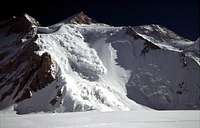
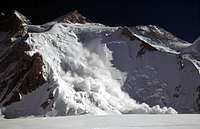
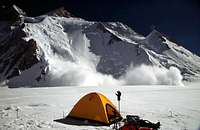
A huge avalanche on the face in between the two peaks.
Walking out via Gondogoro Pass
Gondogoro Pass (or La as it is in the local language) is sometimes stated to be the highest pass in the world and the altitude given on many maps are over 5900m. It's not that high, but at 5600m it's still a very impressive pass. Many teams choose to walk out this way because of the outstanding views from the pass summit. Masherbrum (7821m) is very close and to your NW you see the whole Gasherbrum group, Chogolisa (7665m), Baltoro Kangri (7800m) and a lot of other high beautiful peaks. To the north K2 and Broad Peak are visible. In the south the extraordinary Laila Peak can be seen.From Concordia it's a long day's walk to Ali Camp. First you walk past Mitre Peak and head up the next valley/glacier on your right hand side. Coming from Gasherbrum III's base camp, there's an even longer day's walk. Try to get over the rivers early on the walk down the valley. Watch out for rock falls when entering the valley and try to gain access to the icy part of the glacier as soon as possible. Better to walk up there then down in the scree. When approaching Ali Camp, watch out for crevasses. The "security team" of Ali Camp will scream at you, where and where not to walk.
Ali Camp has a 100 Rps./night fee. Ridiculous prices for "nature preservation" (there's loads of garbage all oer the place), "guiding services" (I never saw any guides when I walked over the pass) and "security" (some bad plastic ropes, attached in extremely bad way is to be seen close to the summit of Gondogoroa Pass) has to be paid. For 1-3 persons it's 2500 Rps. For 4-8 persons it's 4500 Rps. The pass is privately owned. That is probably why this scam can go on as it does. My advice is to bugger the "guides" staying in Ali Camp about the garbage and not trusting the ropes at all.
I was told the it would take 5-7 hours to reach the pass from Ali Camp. It took me 2.45. For an acclimatized mountaineer, this is probably normal. It can be very windy on top of the pass, as it is a lot of elevation drop on the SW side. Don't trust the ropes on this side either. It's quite steep on this side (40-45 degrees). Stay up high on the right hand side if no tracks. There are glaciers in the middle of the glacier further down. The path gets really good before the little camp site of Xhuspang/Shispang, where you also can get very basic meals.
The glacier gets more difficult to travel after the camp and when you have passed the first rocky part and entered the main valley, stay to the left all the time. Doing so makes you avoid all the large crevasses and the left hand side is also the side you leave the valley on. When at the bottom of the first valley, take a left and enter some very nice meadows with yaks. Excellent views of sharp peaks. Some tricky, slide sections have to be passed. The walk gets easier again when heading down the lower part of the Gondogoro glacier towards Shaishcho. In this little settlement you can eat and pitch your tent under nice-smelling wild roses. 100 Rps./night per tent.
From here it's a very easy 3 hour walk to Hushe.
The Hushe - Skardu road is of awful condition for the first couple of hours. In the summer of 2005 the road had been badly cut away by a big river and all travellers had to walk over a wild river on small logs. Other jeeps were waiting on the other side. Lots of apricot orchards followed. From close to Khaplu the road is asphalt all the way into Askole. Count on 5-8 hours from Hushe to Askole.
Red Tape
Visas:
Visas are required by nationals from most European and English-speaking countries. Validity period and cost varies a lot depending on which passport you carry.
Some Pakistani Embassies around the world
Visa extensions are available in most major cities in Pakistan, but should be avoided in the really large cities as it can be a long and nerve-wrecking experience. For Gasherbrum III climbers, Skardu is a recommended place for extensions. See also the Skardu section
Permits for Gasherbrum III
You need a permit to climb the peak, which you can get hold either via the Ministry of Tourism or via an expedition agent. The fees were dropped to half of the old price some years back and the going prices for 2005 are as follow:
A trekking fee is also appliciable in the Gasherbrum III area. It's US$50.
If you join a commercial expedition you don't have to think about the fees for the liaison officer (LO) which is a must in this area of Pakistan. If you walk in via Askole, you need a LO all the way from the military checkpoint some hours out of Askole. If you choose the Gondogoro Pass/Hushe option you can walk in without a LO. When you climb the Gasherbrum III, every group needs to have a LO attached.
If going independently, you're supposed to pay the salary for the LO. Here's the full story, which also give you info about the obligatory briefing and de-briefing.
An environmental fee of $200 also have to be taken into account. There's a refundable bond of $6000 which most expeditions have to pay. Count on it. I was probably just lucky no one asked me about it.
If you attempt a peak lower than 6500m in this restricted area, a Ministry of Tourism approved guide has to be in your company. It's is much cheaper and straight forward than dealing with a LO.
2010
Karrar Haidri, representing the the Executive Council Alpine Club of Pakistan forwarded me the following information.
Government of Pakistan vide Notification. 1(1)/2002-OP, dated 15th October 2008. In suppression of all previous notifications regarding announcement of concessions for Mountaineering, Ministry of Tourism, Government of Pakistan has decided to continue reduction in royalty fee during the calendar Year 2010 as per details given below:
1. Zero royalty fee for peaks up to 6500-M.
2. 10% royalty fee on mountains situated in Chitral, Gilgit and Ghizer except on Spantik/Golden Peak.
3. 05% royalty fee on all peaks during winter season (December- February).
4. 50% discount on royalty fee on all peaks except as mentioned in (1) and (2) above as per following break-up:
The prices after reduction:
K-2 8611m $6000 for 7 member for additional member $1000
8001-8500m $4500 for additional member $750
7501-8000m $2000 for additional member $250
7001-7500m $1250 for additional member $200
6501-7000m $750 for additional member $150
Camping
It's allowed to camp anywhere along the route to Gasherbrum III. Most climbers who go to the area have bought a package deal from an organizer and therefore a high majority of campers stay in the official campsites along the way. Some of them are clean and well-equipped places, some looks more like garbage dumps (Ali Camp and Concordia) and some are only detectable by some spartan wind shelters built by piled up rocks.
Apart from the camps at Paiju, Jhula and Urdukas there is no reason to stay at the official places as they often are crowded and noisy places.
Pitch your tent anywhere, but be careful with the water conditions close to places where many people camp or have camped.
In the main Gasherbrum base camp the liaison officers are very strict about where you camp. This is because of its sensitive location close to both the Indian and the Chinese borders. Normally you have to camp where the rest of your expedition and LO camp.
Maps
A very good clickable map, which covers all the main parts of Karakoram. Good links to further information.When To Climb
June to September is the normal climbing season.Gasherbrum III has never been attempted off season. Extreme cold, high avalanche risk, difficult logistics and deep snow, to mention a few factors, will probably hinder any attempts on this forgotten peak for many years to come.
Mountain Conditions
There are many expeditions going to the other two Gasherbrums over 8000m and as Gasherbrum III shares the same base camp, there are lots of expeditions there during the climbing season. Many of them have satellite communication capability and many of them are also online on a daily basis, i.e. you can get plenty of info about the weather.
The K2 weather report also apply for Gasherbrum III
Main site of Adventure Weather.com
The Pakistani army people on the Baltoro glacier keep a close check on the weather. Another good source of info, but let you LO make contact with the army base, as it’s not a good idea to walk up there by yourself.
Skardu
Skardu is a little town where you'll spend a day or two and is the last outpost of "real civilisation".Porters
Contrary to what some organizers are telling you, you can arrange the trek all by yourself.
The porter salary system was strict and worked fine until 2004, when massive amounts of climbers arrived for the K2 anniversary. A shortage of porters made some organizers desperate and they had to bid over the governmentally fixed prices. This created havoc and the whole porter salary system collapsed.
The cost for a porter is now down to your bargaining skills. Officially it should be roughly 2850Rps. to Gasherbrum III base camp, but count on paying 4500Rps (excl. food for porters, otherwise 5500-6000Rps).
Porters can be found in Askole, but if there are a lot of expeditions leaving when you get there, there is a high risk there are none available. Better book beforehand. The organizers are not very happy to help you out with this, as they want to include you in a group, but the small hotels in Skardu can usually help you. The price mentioned above is the full price, which include sunglasses, gloves etc. for the porter.
What is not included in the price are the below items and you have to supply the group of porters with the following:
All the above is best bought in Skardu.
Food/porter 1100-1300Rps.
The rest on the list 600Rps. (10 litres of kerosine).
Commercial Expeditions/Organizers
There are a lot of companies which can offer you a package deal for all the higher peaks in Pakistan. As Gasherbrum III is such an "unpopular" peak very few organizers have it mentioned in the standard program. I choose to list the ones I personally have encountered on my journeys. Random order.
Local organizers
Hushe Treks & Tours
Local organizer which has been around for a long time.
Nazir Sabir Expeditions
Supposedly the best organizer, according to many Pakistanis. A bit more costly than the average organizer.
Karakurum Treks & Tours
Another company with lots of experience and good reputation.
Karakurum Magic Mountains
A quite new company with great services.
Karakorum Explorers
Small but experienced company.
Saltoro Summits
SP member Karrar's company.
Foreign organizers
Jagged Globe
Base: UK.
Footventure
Base: UK.
Tikmountain
Base: Italy.
Recommended!
Amical
Base: Germany.
Useful addresses and information.
North Pakistan tours
Ishaq Ali Geologist
Po Box 463
Islamabad
Pakistan
Alpine Club of Pakistan
Jinnah Stadium,
Pakistan Sports Complex,
Islamabad.PAKISTAN 44000
Tel: 92-51-9208963
http://www.alpineclub.org.pk/
Basic information about Pakistan
Money & CostsCurrency:
Pakistani Rupee.
141.60 Rps = 1 US$ in April 2019.
Relative costs:
Road side restaurants: US$ 0,5-1,5
Budget meal: US$2-3
Moderate restaurant meal: US$3-8
Top-end restaurant meal: US$5-10
Budget room: US$1,5-5
Moderate hotel: US$10-15
Top-end hotel: US$22 and up
By staying in hostels or dorms and eating like a local you can get by on as little as US$3-10 a day. If, however, you were looking for a moderate touch of luxury you could spend as much as $30-40 a day which could get you accommodation that included a satellite T.V., a desk, a balcony, and a spotlessly clean bathroom. As in any place you can spend as much as you like to live in the lap of luxury and stay in swanky hotels. It's worth noting that rooms and food are cheaper in the north than in the south.
Both travellers cheques and cash are easy to change throughout the country, but commissions on cheques can be high. Apart from top-end hotels most places won't accept credit cards as payment although you can often use them for cash advances at western banks. Facilities for validation seem better for Visa then Mastercard. Occasionally a tattered note will be firmly refused as legal tender, and often in the smaller towns the appearance of a 1000 or 500 rupee note will cause consternation and an inability to provide change so make sure you get some smaller notes when buying your rupees.
A reliable place for using Visa/Mastercards (ATM and cash withdrawals) is the Citibank in the Blue Area in central Islamabad.
Tipping
Baksheesh isn't so much a bribe as a way of life in Pakistan. It can apply to any situation and is capable of opening all sorts of doors, both literal and metaphorical. Anything from a signature on a document to fixing a leaking tap can be acquired through the magic of baksheesh. Most top-end hotels will automatically add a 5-10% service charge to your bill so any extra tipping is entirely up to you. Taxi drivers routinely expect 10% of the fare, and railway porters charge an officially-set Rs 7. The only time that a gratuity might not be welcome is in the rural areas where it runs counter to Islamic obligation to be hospitable.
As everywhere else, make sure the tip is not over the top. It only makes it hard for both future travellers and the locals.
Be sure to read the situation right before using the baksheesh way. Some officials and army personal can be very touchy and it can really backfire offering the wrong person a baksheesh.
Bargaining
If baksheesh is a way of life, bargaining is a matter of style, particularly in the many Pakistani bazaars. Unlike the western hesitancy for bargaining, shopkeepers in Pakistani love to bargain as long as it's done with style and panache. Bargaining usually begins with an invitation to step inside for a cup of tea followed by a little bit of small talk, a casually expressed interest by yourself in a particular item, a way-too-high price mentioned by the seller, a way-too-low counter offer by yourself and eventually, after much comic rolling of eyes, a handshake and mutual satisfaction for both parties. Bargaining should always be accompanied by smiles, good humour and an ability not to get fixated on driving the price into the ground.
Climate in the different provinces
The best time for travelling to Pakistan depends on which part of the country you intend to visit. Generally speaking the southern parts of Pakistan including Sind, Baluchistan, Punjab and southern NWFP are best visited in the cooler months between November and April. After that it gets uncomfortably hot. The northern areas like Azad Jammu Kashmir, and northern NWFP are best seen during May to October before the area becomes snowbound. The weather may be a little stormy during this time but the mountain districts are usually still accessible.
Ramadan
Try and avoid Pakistan during Ramadan, the Muslim month of fasting which, usually occurs sometime during the months of December to early January. This is because a fasting Muslim is an understandably cranky Muslim, and you may find yourself involuntary joining in the fast because activity is kept to a minimum and food is hard to find during daylight hours. Pakistanis are usually very understanding when it comes to westerners who aren't muslims. Even if there are no tea or food served to muslims, these items are most of the time readily available for believers in other faiths.
Security
The security situation in Pakistan deteriorated through 1997, with areas previously considered safe experiencing the same sort of violence and crime as in the long-troubled Sind region. As well as the danger of being caught up in sectarian skirmishes, travellers have been the specific target of violence in Karachi and Lahore.
Sind, the region in the south of Pakistan which includes Karachi, was known as the `Unhappy Valley' or the `Land of Uncertainties' by ancient travellers. Switch to the present day and news of curfews, foreign kidnappings and atrocities between the two main ethnic groups - Sindhis, the province's indigenous inhabitants, and the Mohajir, Muslim refugees from India - suggests its former name is still not out of place. With robbery, smuggling and gun-running amongst Sind's biggest
industries, the province remains a highly dangerous place to visit.
Travel to Sind as well as to the North-West Frontier Province, Punjab and Baluchistan should be undertaken with caution and only after consulting a national foreign affairs department prior to departure or a consulate in Karachi for current information.
Many low end hotels are infamous for theft from the rooms.
The Northern Areas are usually very safe and out of a climbers point of view this is the most important issue. The worst you probably encounter is snotty kids throwing a rock or two and a really annoying feature is the "one-pen-kids". Please do not encourage this behaviour by handing out gifts willy nilly. It only creates greed, beggary and a hell time for forthcoming travellers. If you want to give pens, hand it over to the local teacher/local.
Health
Shots against dengue fever, hepatitis A, malaria and, in rural areas, Japanese encephalitis are recommended.
The tap water should be avoided all over Pakistan.
Giardia and amoebic dysentery is endemic all over the country and Flagyl (metronidazole) is one of the more essential drugs to bring.
Miscellaneous
Time: GMT/UTC plus five hours
Electricity: 220V, 50 Hz
Weights & measures: metric
Tourism: 424,000 visitors
External Links
- A report about the Basque expedition
- The Basque expedition and also about other Basque climbs
- A brief about the second ascent on Desnivel
In Spanish
- Jasmine Tours - Pakistan
We run annual trip to all 8000m mountains in Pakistan.
- Saltoro Summits
We constantly aim to provide superior and high quality services at competitive prices.


